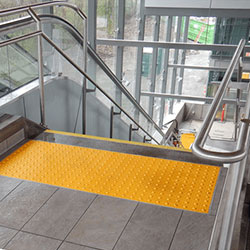









Over 1.5 million Canadians are visually impaired, and an estimated 5.59 million more have sight loss causing eye disease. For these individuals, navigating public spaces can be challenging and unsafe without proper accessibility accommodations. Tactile warning systems provide an invaluable service by alerting visually impaired pedestrians to potential hazards and guiding their movement through the built environment.
As a leading Canadian supplier of tactile warning systems, Tactile Solution Canada is committed to enhancing accessibility and mobility for the visually impaired. We offer a wide selection of tactile warning products, including detectable warning surfaces, wayfinding indicators, and exit signs. Our systems are designed to meet the latest accessibility standards and codes in Canada.
Tactile warning surfaces like truncated domes alert visually impaired individuals to upcoming hazards like stairs, ramps, level changes, and road crossings. The unique texture is easily detected by a person's feet or cane, warning them to stop, slow down, or proceed with caution. This helps prevent potentially dangerous falls or collisions. Proper use of tactile warnings has been proven to reduce accidents among visually impaired pedestrians.
Wayfinding indicators like raised bars guide users along a set path or route. These tactile cues help visually impaired Canadians navigate safely through open spaces, transit platforms, and complex building interiors where maintaining a straight path is difficult. Wayfinding strips provide confidence for independent travel.
Tactile systems allow visually impaired citizens to access and utilize public spaces in their community. With proper installations that meet guidelines like the CSA B651 Standard in Canada, visually impaired individuals can travel safely and comfortably through areas like sidewalks, stairways, parks, transit stations, and information centers. Tactile warning systems are a key accessibility accommodation required under the Canadian Human Rights Act.
For many visually impaired Canadians, the ability to travel independently is linked to quality of life. Tactile warning systems give users the confidence to navigate their environment without constant reliance on sighted guides. This allows for greater autonomy and freedom in everyday tasks. Mobility and independence are critical factors for mental health and social participation.
Standardized tactile warning systems give visually impaired travelers consistency across different cities and provinces. For example, a truncated dome surface alerts a user to the edge of a train platform whether they are in Toronto, Vancouver, or Moncton. Consistent tactile cues allow for intuitive understanding and safe travel regardless of location. It also streamlines accessibility for organizations that operate across Canada.
While tactile warning systems offer immense benefits, their effectiveness depends greatly on proper installation and maintenance. Here are some key considerations:
Complying with standards and installing tactile systems properly is imperative for both safety and creating an accessible environment.
Blindness or low vision should not prevent full participation in society. With Canada’s aging population, the need for thoughtful accessibility will only increase in the future. Tactile warning surfaces and indicators fulfill a critical need for safe navigation by providing standardized, intuitive information underfoot.
While key to accessibility for visually impaired individuals, tactile warning systems offer benefits for all pedestrians. Children, seniors, distracted cell phone users, and those under the influence can all appreciate the extra safety cue. Tactile surfaces enhance walkability and security in public spaces for all citizens.
At Tactile Solution Canada, our goal is to create modern, integrated accessibility to improve mobility and quality of life for Canadians with vision loss. Contact our knowledgeable team today to discuss how tactile warning systems can enhance safety, accessibility, and experience at your next project site.
A: Key documents include the CSA B651 Standard, Ontario Building Code, and Accessibility Design Guidelines in major cities like Toronto and Vancouver. These outline proper applications, dimensions, and installation methods for tactile pavers and surfaces.
A: Domes should be installed at stairs, pedestrian crossings, ramps, transit platform edges, and other hazardous drop-offs or level changes per Canadian codes.
A: Common options are metal, composite, plastic, and rubber. Durability, aesthetics, price point, and lifespan factor into material selection.
A: Consult with suppliers early in the process to seamlessly incorporate tactile into the overall site layout, color scheme, and flooring materials.
A: Schedule inspections, train staff to spot damage, and keep spare materials on hand for repairing surfaces. Proper maintenance ensures accessibility is preserved.
At Tactile Solution Canada, we offer consultations to help you select appropriate tactile solutions tailored to your specific project site, needs, and goals. Contact us today to discuss enhancing accessibility!
